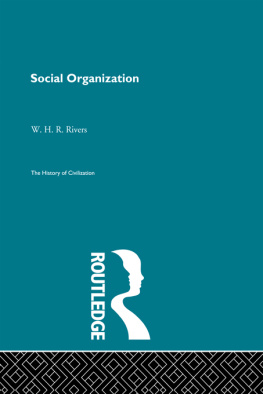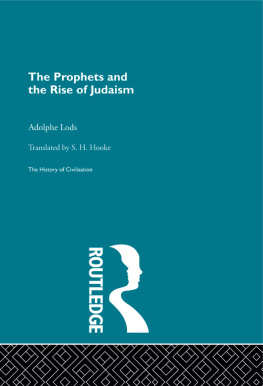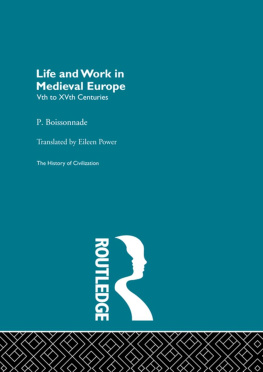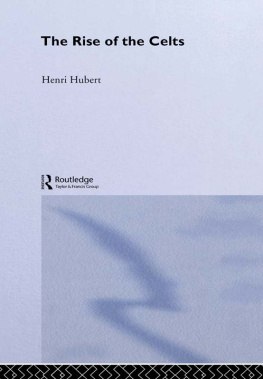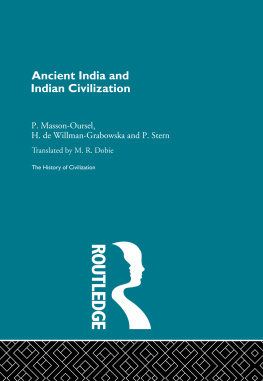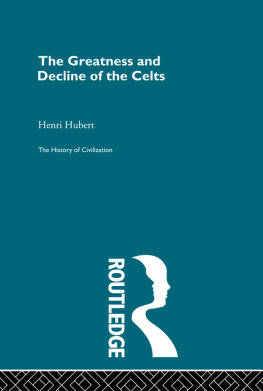THE HISTORY OF CIVILIZATION
THE JEWISH WORLD IN THE TIME OF JESUS
THE HISTORY OF CIVILIZATION
General Editor C. K. Ogden
The History of Civilization is a landmark in early twentieth Century publishing. The aim of the general editor, C. K. Ogden, was to summarise in one comprehensive synthesis the most recent findings and theories of historians, anthropologists, archaeologists, sociologists and all conscientious students of civilization. The History, which includes titles in the French series L'Evolution de l'Humanit, was published at a formative time in the development of the social sciences, and during a period of significant historical discoveries.
A list of the titles in the series can be found at the end of this book.
THE JEWISH WORLD IN THE TIME OF JESUS
Charles Guignebert
Translated by
S. H. Hooke

London and New York
First published in 1939 by Routledge, Trench, Trubner
Reprinted in 1996 by Routledge
Reprinted 1998, 2000
2 Park Square, Milton Park,
Abingdon, Oxon, OX14 4RN
&
270 Madison Ave,
New York NY 10016
Transferred to Digital Printing 2005
Routledge is an imprint of the Taylor & Francis Group
1996 Routledge
All rights reserved. No part of this book may be reprinted or utilized in any form or by any means electronic, mechanical, or other means, now known or hereafter invented, including photocopying and recording, in any information storage or retrieval system, without permission in writing from the publishers.
British Library Cataloguing in Publication Data
ISBN: 0-415-15598-3
ISBN Judaeo Christian Civilization
(4 volume set): 0-415-15615-7
ISBN History of Civilization (50 volume set): 0-415-14380-2
CONTENTS
BOOK I
THE POLITICAL AND RELIGIOUS CONDITION OF PALESTINE
CHAPTER
BOOK II
INNOVATIONS AND FOREIGN INFLUENCES
BOOK III
THE REAL NATURE OF JEWISH RELIGIOUS LIFE IN PALESTINE
BOOK IV
HELLENISTIC JUDAISM
FOREWORD
THE MORAL CRISIS IN THE ANCIENT WORLD. THE APOCALYPTIC OUTLOOK AND THE RESULTS OF SYNCRETISM
THE present volume is of special interest, because it deals with one of the most troubled periods of human history, but one which was, nevertheless, the most rich with promise. In the volumes dealing with the Hellenistic and the Roman world, we have seen on the one hand, the tendency to large-scale political combinations and universal empire, and on the other, the growth of religious intermingling, of what might be called a spiritualendosmosis. In this period the divergent civilizations of the East and the West meet and mingle, producing a tendency at the same time to both scepticism and faith. Amongst the finer minds, the progress of thought and a quickened sense of human misery and oppression give rise to a passionate desire to understand life and death, and the problem of evil, to attain happiness or salvation. We see the birth of a moral crisis in a restless and troubled world as the Christian era draws near.
In these fascinating pages Professor Guignebert examines the causes of this restlessness. The orientation of his study is determined by the fact that the book is an introduction to Jesus. Hence he carries on the history of Judaism which Professor Lods brought up to the middle of the second century B.C., and lays bare the conditions which led up to the appearance of Jesus in a Palestinian environment. But he also makes clear the factors in the circles of the Jewish Diaspora which gave birth to the Christian myth and to Christianity. Hence his book has a threefold interest and a threefold value.
This soil where men and ideas from every direction met (p. 257). Such is the aspect under which Palestine has already appeared to us in the previous volumes dealing with Israel and early Judaism. We have seen that the insignificant people who occupied it were fated by reason of their geographical position to be the prey of their more powerful neighbours. But within its own community it offered a stubborn resistance to the influence of successive foreign dominations, and finally to that of Rome, against whose power it put forth all its efforts to preserve its own individuality intact, and to perfect its own unique religious organization.
Professor Guignebert shows them to be easily offended, suspicious, intolerant, imbued with a religious nationalism intensified by exile. They believed that Jahweh would vindicate their cause, and, accustomed as they were to a foreign yoke, they only rebelled if their religion was threatened or even insulted (p. 41), but then they were stirred to the depths. The Maccab;an revolt represents the climax of these outbursts ofheadstrong action (p. 254), arising more from fanaticism than from the desire for independence. From the time of the return from the Exile the history and the organization of the Jewish people are both entirely religious.
It has been shown that the monarchy had played no great part in the history of Israel save in a few instances; it had increasingly developed into a theocracy, and all power had fallen into the hands of the priestly class. The present volume gives us illuminating information concerning the power of the priesthood; concerning the observance of the Law, which, unrelated to life, having as its motiveto establish a theocracy, and at the same time to authenticate and justify it, reflectedthe clerical desire for some settled and final scheme of organization (p. 63); and concerning the development ofreligious jurisprudence (p. 69).
The Sanhedrin was an assembly which befitted the nature of its people, the people of the Torah (p. 78). It consisted of the priestly aristocracy and the doctors of the Law, with the High Priest as its president. During the course of a century the Hasmoncean princes, who were at the same time High Priests, embodied in their own persons the union of political power and religious authority. The Temple, as the place where sacrificial ritual linked the people with their God, was almost as much thecentre of public life (pp. 59, 61) as the shrine of the national religion. It was an elaborate organization and its staff, according to Josephus, comprised as many as 20,000 persons.
The Law, the absolute standard of all religious life (p. 64), needed to be interpreted and adjusted to circumstances; hence the hierocraey had to be supplemented by a nomocracy. Just as the previous volume explained the psychology of the prophets, so the present volume explains that of the Scribes or Rabbis.than they have been often represented. They were not only jurists and canonists, but also moralists and casuists (p. 69), but the schools which they founded were not always characterized by the same spirit.
It was by means of the synagogue, acentre of religious instruction (p. 74), and a sort of popular religious university (p. 75), that contact between the Scribes and the people was established. Unique of its kind in the ancient world, the synagogue was a religious institution where worship consisted in the zealous study of the divine revelation; and, although one of the results of that study was a narrow formalism and a casuistic subtlety in the application of the Law, yet it also resulted in a liberal interpretation and adaption of the Law to the needs of daily life


